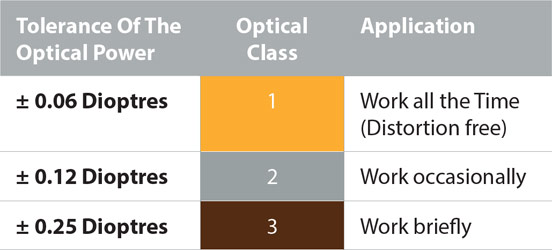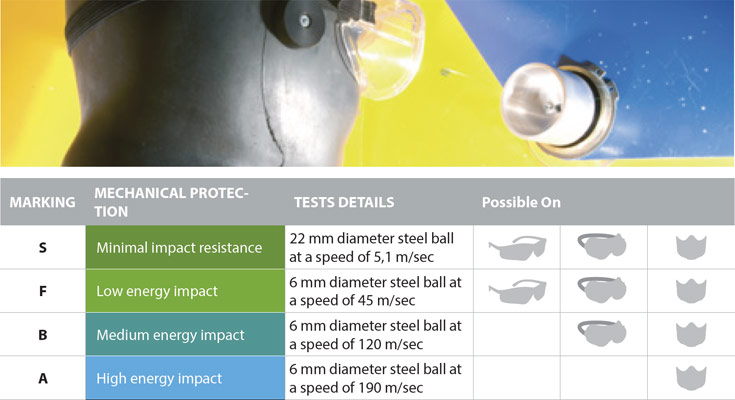
EN353-2 relates to systems made up of a line intended to be fixed (either temporarily or permanently) to a structure at the top only, on which a travelling device is attached. The user connects to this travelling device when climbing or descending – in the case of a fall, the travelling device should grip the line and arrest the fall.


Tests include: transmission and diffusion of light, refractive properties, resistance to aging (stability to heat and resistance to UV), corrosion and ignition. Results of the testing define the Optical Class of the eye protector: which falls into 1 of 3 categories, where 1 is the highest and 3 is the lowest as indicated in the table. These categories define the quality of the lens in terms of how much or how little distortion is experienced by the wearer.

This test (applicable to both lens and frame) determines the impact resistance of the eye protector (spectacles, goggles or visors) to withstand flying objects without cracking or shattering. The test is performed with steel balls of different diameters and weights which are used to strike the lens and frame at different speeds as indicated in the table. This results in 4 levels of mechanical protection denoted by the markings; 'S' 'F', 'B' or 'A' on the eye protector where 'S' is the lowest grade, offering the least amount of protection and 'A' is the highest grade offering maximum protection under the standard.
Note: spectacles can only get a S or F marking, goggles can have a S, F or B, whereas grade A is applicable to visors only.

EN 166 also describes other optional tests which must be applied should the manufacturer wish to make additional claims regarding protection. For example, the Impact Resistance Against High Speed Spectacles At Extreme Temperature is conducted on spectacles/goggles and visors conditioned at extreme temperatures from -5°C / +55°C, resulting in similar markings as the above table, with a T denoting temperature: FT / BT / AT. Note: This does not apply to the S marking category.

See the table to the left to see other optional requirements and their corresponding markings for EN 166.
Ensure your safety in hazardous environments with the Portwest Arc Flash Visor Class 1 - Clear. This premium visor not only guarantees to shield your face but also provides the highest level of light transmittance, enhancing colour recognition as per the standards of EN 170. Let us look at the features that make this product a vital addition to your safety gear:
Engineered following high standards, the Arc Flash Visor has been classified as a class 1 protection gear according to GS-ET-29 and complies with E DIN 58118. It holds certifications from ECS GmbH - European Certification Service, verifying its quality and reliability through the following standards:
Invest in the Portwest Arc Flash Visor Class 1 - Clear for an unmatched level of safety and convenience. Its thoughtful design ensures that you donít have to compromise on your safety while enjoying enhanced visibility and comfort. Make it a part of your safety ensemble to experience a superior level of protection.
Please see our PPE disclaimer at the bottom of the page.
Specifications are subject to change - See Terms & Conditions for more info
Portwest has been independently rated by Ecovadis for its environmental, social, and ethical performance and achieved a silver rating, meaning they are in the top 25% of globally rated companies.
The pillars taken into consideration include the environment, labour practices and human rights, ethics, and sustainable procurement.
This product conforms with essential health and safety requirements as set out in European Directives.
This product is CE marked as a Category 3 item for complex design.